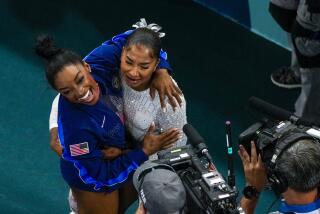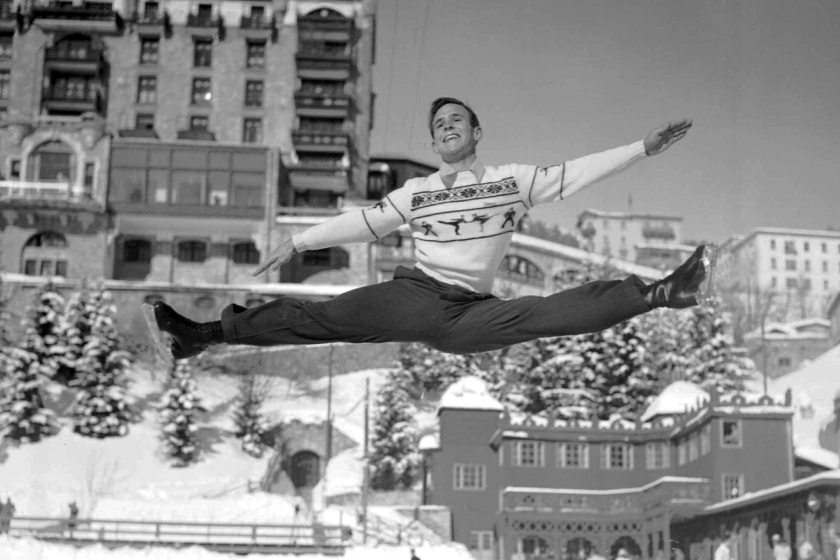EASTERN RHYTHM WESTERN BEAT : Agoura’s Irina Rubinshtein Scales the U.S. Rankings in Rhythmic Gymnastics, a Sport With European Roots and Growing Interest
- Share via
Irina Rubinshtein is on a diet. At 5-4, 103 pounds, some might say she is already fashionably slim, but not Irina.
The 16-year-old’s fashion standards aren’t based on Madonna, MTV or even boys. They’re set by elfin girls named Marina and Galina who move like quicksilver across a gymnastics floor while they twirl ribbons or juggle pins in a graceful dance routine.
“The Bulgarians and the Russians . . . have so much expression, and they’re so flexible and thin,” groans Rubinshtein. “I just want to reach their level.”
Rubinshtein is a rhythmic gymnast, a determined American player in a sport that is little known outside Eastern Europe.
Introduced into the Olympics as a separate sport in 1984, rhythmic gymnastics is a mixture of regular gymnastics and modern dance with a little ballet thrown in. (Until 1956, when the sport was dropped from the Olympics, it was part of the gymnastics repertoire.) Keeping time to music, athletes perform choreographed sequences of up to 1 1/2 minutes using either a plastic ball, multicolored ribbon, pins--better known as clubs--or rope.
Rubinshtein is ranked third nationally in the sport. Last week, the Agoura teen-ager returned from the Goodwill Games in Moscow, where she placed 19th--no small feat when you consider that Americans only began learning the sport about 13 years ago.
That was when several talented rhythmic gymnasts were among the tide of Soviet Jews allowed to immigrate to the West. Those gymnasts--and children of other immigrants who brought a love of the sport from their homeland--provided a core in those first years. Eventually, a handful of clubs was started, and USSR-born coaches began recruiting limber young American girls.
Rubinshtein’s family emigrated from Odessa in the Soviet Union in 1976, when she was 6, but little remains of her foreign origins. She is fluent in Russian, the language her family speaks at home, and her delicate skin coloring and wide blue eyes reveal her roots.
At one moment, she seems poised and intelligent beyond her years. But Rubinshtein can quickly lapse into typical teen-age Angst as she complains about her continual diet or mourns her lack of social life at Agoura High, where she will be a junior this fall.
“I don’t think I’m considered popular. I don’t go to the football games, I go to workouts,” says Rubinshtein, whose days start before 6 a.m. and don’t end until after midnight. She practices four to five hours a day, six days a week, and sometimes wishes she could give it all up “and be normal.”
Rubinshtein doesn’t bear the burden alone. Until this year, when she received her driver’s license, Rubinshtein’s mother, Larisa, drove her back and forth to UCLA for workouts, where she practices with Alla Svirsky, coach of the U.S. rhythmic gymnastics team.
For Larisa Rubinshtein, a Van Nuys engineer who had to rearrange her work schedule to accommodate her daughter’s classes, rhythmic gymnastics has meant a daily two-hour commute with four hours to kill in between.
“I know every restaurant in Westwood,” Larisa Rubinshtein said wearily. “I know all the prices in the stores. Sometimes I would just wait in the car, I was so tired.”
Rubinshtein’s parents also racked up expensive airline bills because one parent usually accompanied her on trips to lend moral support. Then there were fancy leotards that cost upwards of $75, balls and other props that ran $35 each, monthly lessons at $275, special shoes, hotels, restaurants and spending money for trips.
But the Rubinshteins don’t mind sacrificing time and money for their daughter, even though they acknowledge that she will probably never rank as a world champion because of the technical virtuosity of the Bulgarians and the Soviets.
Had the family stayed in the Soviet Union, Rubinshtein “would not have been allowed to compete past the city level because she is a Jew,” her mother said.
Rhythmic gymnastics “will help Irina in her life,” she adds. “When we drive to workouts, she tells me, ‘Today, I have a goal. It is to do this flip successfully.’ She has become very organized. No matter what she does in the future, she will be able to set goals for herself.”
In addition to organization, rhythmic gymnastics requires stamina and precision, Irina said.
“You can’t look sloppy,” Rubinstein says. “The judges look at your hair, body, face, leotard, equipment. . . . If a pin falls out of your hair, they take off points. Some things get really ridiculous.”
Done right, rhythmic gymnastics can be sublime to watch. With a fluid performer, the props become almost an extension of the body, controlled as if by some hidden magnetic field. A ball can rise 30 feet into the air, only to be caught on the other end of the floor by a supple gymnast who goes into a backward swoon.
It is also a sport that is growing in popularity, thanks to the 1984 Summer Olympics. Rubinshtein, who has studied since age 10, recalls that, when she first attended national meets, there were about 20 competitors. Today, Rubinshtein says, national meets draw at least 100 participants.
Today she is in Texas to participate in the Olympic Sports Festival, a mini-Olympics for Americans. But Rubinshtein prefers foreign competitions, although often “we get to see just the airport, the gym and the hotel.” Each time she goes abroad, she brings home a doll from the country. She has collected about eight.
The Los Angeles team also goes abroad to train; last year, it traveled to Bulgaria to train with that country’s national team coach. It was a good experience, gymnastically speaking, but a gastronomic disaster, Rubinshtein recalls.
“We had gross food in Bulgaria,” she says flatly, describing soup with lots of fat, potatoes drenched in oil and meat that tasted like the sole of a shoe.
But then she brightens. “We also lost a lot of weight there.”
After that experience, the team took granola bars, soup and crackers with them when they competed in Hungary in spring. It was a lucky decision because the team was in Eastern Europe during the Chernobyl nuclear disaster. When the American embassy warned them not to eat fresh produce, milk or meat, the team was well supplied.
The scariest experience, however, proved to be returning to the Soviet Union this month, a country Rubinshtein barely remembered after 10 years in America. Her parents said they feared that KGB agents might try to stir up trouble for Irina, who still has family in Odessa.
But the trip went off without a hitch--if the group didn’t count the plainclothes security officers that followed them everywhere. For Rubinshtein, her teammate Marina Kunyavsky, their coach Svirsky and piano player Bella Frank, all of whom were born in the Soviet Union, it was an uneasy homecoming.
Another USSR-born gymnast, 15-year-old Alexandra (Shura) Feldman of Sherman Oaks, remained at home because her parents would not allow her to go to Moscow, Rubinshtein said.
Rubinshtein herself recalls only one unpleasant moment, when she ran up to greet an uncle in the sports stadium and he turned away because she was American. Later, in the privacy of her dressing room, he hugged her emotionally and asked for news of her family, Rubinshtein said.
For now, Rubinshtein is happy to be back in Agoura, where her immediate goal is to enjoy the summer. An intermediate goal is the 1988 Olympics in Seoul, South Korea, after which she plans to retire at the ripe old age of 18.
And then?
Then comes college, at UCLA, where Rubinshtein wants to major in mathematics--the only subject that comes easily to her, she says. But she doesn’t plan to give up rhythmic gymnastics completely.
“Maybe I’ll become a TV sportscaster,” she muses as she looks admiringly at the Soviet and Bulgarian rhythmic gymnasts, who perform as gracefully as gazelles on a videotape of the Goodwill Games in her suburban home.
More to Read
Go beyond the scoreboard
Get the latest on L.A.'s teams in the daily Sports Report newsletter.
You may occasionally receive promotional content from the Los Angeles Times.






